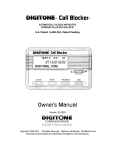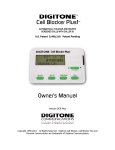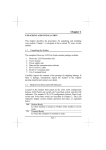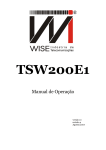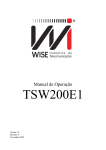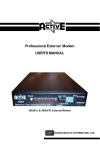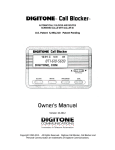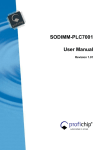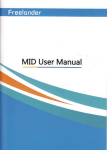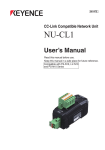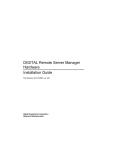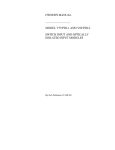Download Advantech PCM-3601 User manual
Transcript
PCM-3601 USER MANUAL Copyright notice This document is copyrighted, 2000, by Advantech Co., Ltd. All rights are reserved. The original manufacturer reserves the right to make improvements to the products described in this manual at any time without notice. No part of this manual may be reproduced, copied, translated or transmitted in any form or by any means without the prior written permission of the original manufacturer. Information provided in this manual is intended to be accurate and reliable. However, the original manufacturer assumes no responsibility for its use, nor for any infringements upon the rights of third parties which may result from its use. Acknowledgements AMD is a trademark of Advanced Micro Devices, Inc. Award is a trademark of Award Software International, Inc. Cyrix is a trademark of Cyrix Corporation. IBM, PC/AT, PS/2 and VGA are trademarks of International Business Machines Corporation. Intel and Pentium are trademarks of Intel Corporation. Microsoft Windows ® is a registered trademark of Microsoft Corp. RTL is a trademark of Realtek Semiconductor Co., Ltd. C&T is a trademark of Chips and Technologies, Inc. UMC is a trademark of United Microelectronics Corporation. Winbond is a trademark of Winbond Electronics Corp. STPC is a trademark of SGS Thomson Corp. For more information on this and other Advantech products, please visit our website at: http://www.advantech.com For technical support and service, please visit our support website at: http://www.advantech.com/support This manual is for the PCM-3601. Part No. 2006360100 1st Edition Printed in Taiwan June 2000 2 Chapter 1 Unpacking and Installation This chapter describes unpacking and installing your modem. 1.1 Feature FDSP (Full –duplex speakerphone) - Acoustic and line echo cancellation - Microphone gain & muting - Speaker volume control and muting Data modem throughput up to 115.2K bps - V.90 56000, 53333, 51200, 50667, 49333, 48000, 46667, 45333, 44000, 42667, 41333, 40000, 38667, 37333, 36000, 34667, 33333, 32000, 30667, 29333, 28000 bps - K56flex 56000, 54000, 52000, 48000, 46000, 44000, 42000, 40000, 38000, 34000, 32000 bps - V.34 33600, 31200, 28800, 26400, 24000, 21600, 19200, 16800, 14400, 12000, 9600, 7200, 4800, 2400 bps - V.32bis 14400, 12000, 9600, 7200, 4800 bps - V32 9600,4800 bps - V.23 1200/75 bps (originating mode transmit at 75 bps and receive at 1200 bps; answering mode transmit at 1200 bps and receive at 75 bps) - V.22bis 2400,1200 bps - V.22 1200 bps - V.21 300 bps - Bell 212A1200 bps - Bell 103 300 bps - Automatic modulation negotiation using ITU-T V.8bis/V.8/V.32 Annex A. Fax modem send and receive rates up to 14400 bps Page: 1 - ITU-T G3 FAX Modulation - CLASS 1 & CLASS 2 Command - ITU-T T.30 - ITU-T V.17 14400 to 9600 bps - ITU-T V.29 9600 to 4800 bps - ITU-T V.27ter 4800 to 2400 bps - ITU-T V.21 Channel2 300 bps Error Correction & Data Compression - MNP2 – 4 (ALT) - MNP5 (ALT/CLASS5) - V42 (LAPM) - V42bis (BTLZ) Voice/audio mode - Voice transmit mode: PCM or ADPCM - Enhanced ADPCM compression/decompression - Tone detection/generation and call discrimination - Concurrent DTMF detection - 8-bit monophonic audio data encoding at 11.025K HZ or 7.2K HZ NVRAM directory and stored profiles - NVRAM SIZE: 256byte - NO OF SCP: 2 - NO OF TEL SET: 4 - Length of each set: 31byte - Total length: 124byte Package - R6764-61 - L2800 100-Pin PQFP (Rockwell) 80-Pin PQFP (Rockwell) H/W SPEC. - Freq. : 28.224 MHz Page: 2 - Working Currency - Working Voltage : 350mA (max) : DC +5V : DC+12V - Working Temperature : 0 – 70 ℃ - Ring Spec. - Tone Spec. : +5.50V ~ +4.50V : +15V ~ 9V : Fq=15Hz ~ 71Hz, V=35Vrms (above) : HGF=-4, LGF=-6, ±2db : HGF=-9, LGF=-11, ±2db(CTR21) - Pulse Spec. : M.B.R=39 ±2 , P.P.S=10 ±0.5 - PCB Size : 96mm X 90mm EMC & PTT Support: FCC Part15 & Part68/CE/CTR21(Option) 1.2 Unpacking the Modem The complete modem package should include: 1) The modem unit. 2) This user manual. 3) An RJ-11 to RJ-11 phone cable. 4) Data and fax communications software (Optional). 5) Windows 95/98 Driver Carefully inspect the package for shipping damage. If damage is found, repack the modem in the original packing material and contact your dealer. 1.3 A Look at the Modem Card Phone: Accepts a Telephone set Connected Parallel to your Modem. Line: Accepts the RJ-11 Cable that links your Modem to a Telephone line or to a 2-Wire Leased-Line. PC/104: The PC/104 connectors give you the flexibility to attach PC/104 modules. Page: 3 Fig 1-1. PC/104 FaxModem Card Page: 4 1.4 The Serial Port and Interrupt of the Modem Card Each peripheral device, such as a modem, uses a port that is either serial or parallel, depending on its design. Each port can only accept one device; otherwise, there is a conflict. Your modem is designed for use with serial ports. You can use any COM port, COM1 to COM4. Some computers, may support only two serial ports. See your computer manual for the number of ports on your computer. Computers use interrupts (IRQ) to control the data flow between computers and peripherals. An interrupt signals data to flow or to stop, much like a traffic light controls the flow of traffic. Each serial port needs an interrupt to control that particular port. 1.5 Setting the COM Port and Interrupt of the Modem Card Your modem is factory set for use on COM4 with IRQ3. If you choose to use it with another serial port or interrupt, you need to change the COM jumper and IRQ jumper. Make sure the port and interrupt set-up you use are not used by any other peripheral. The COM/IRQ settings should appear as in the diagram below. If you have any questions about setting a port for your modem consult your dealer. IRQ Pin Jump Jump J3 1-2 2-3 J1 J2 IRQ4 COM Port COM1 (IRQ4) IRQ3 J4 IRQ5 1-2 1-2 IRQ7 COM2 (IRQ3) 2-3 1-2 J5 IRQ9 IRQ10 COM3 1-2 2-3 J6 IRQ11 IRQ12 COM4 2-3 2-3 J7 IRQ15 Fig 1-2 Modem Card COM/IRQ Setting 1.6 Installing the Modem Card The modem card is designed for reliability, but it should be kept away from static electricity, shock, heat, and humidity. Page: 5 Install the modem into your computer as follows. 1) Turn off the computer 2) Remove the cover of your computer and locate the 5614HP expansion slot. Refer to your computer installation guide. 3) Plug in your 5614HP modem to the expansion slot, and make sure the connectors of the modem card are exactly aligned with the expansion slot. 4) Secure the modem card to the computer with screw. 5) Connect the telephone line from the wall outlet to the jack labeled LINE. 6) Connect the line from your telephone to the jack labeled PHONE. You may leave the PHONE jack unconnected. CAUTION: Handle the card only by its edges. The card precision components are easily damaged by static electricity or abuse. The metal bracket of the modem card should rest firmly on the rear panel bracket of the computer. If not, remove the modem card and try again. 1.7 Testing the Telephone Line Prior to Connection The quality of the telephone line significantly affects the reliability and quality of data communications. Make sure that both the telephone system and telephone line are in good order before the modem is connected. Test the line by lifting the telephone handset and listening for a clear dial tone. Try placing a few calls. If the calls do not go through well or are not loud and clear, you may have a poor quality telephone line. In this case, find a better quality line for your modem to ensure reliable data communications. We strongly recommend that you connect the modem directly to an outside telephone line. Do not connect your modem to a Private Branch Exchange (PBX) telephone system unless the system is proven to perform well under data transmission conditions. 1.8 The Communications Software Configuration Your modem follows the standard modem command set. Most of Page: 6 the popular communications software packages work with your modem. If you have any problem using the software, please contact your software dealer, publisher, or modem dealer. To install the software, turn on your computer and modem, and boot the communications software. Follow the software manual instructions to execute software installation. Software configuration procedures vary with each software program, computer, and application. Refer to your software manual for more information. If you experience any difficulty, consult your dealer. When installing the software, pay particular attention to the following parameter settings, as many beginners fail to successfully set them correctly. 1) The serial port number. 2) The communications protocol. 3) The data format, including data bit, stop bit, and parity. The serial port specified in your communications software must match the serial port to which the modem is actually connected. No matter whether it is COM1, COM2, COM3, or COM4, a port can be only be connected to one peripheral device, and should be specified so. Otherwise, the two devices will conflict with one another, or your computer will not be able to find the proper COM port or other device. To communicate successfully, the protocol and data format of the two modems on-line must be identical. For example, if the bulletin board you are going to dial supports Bell standard, 8 data bits, no parity, 1 stop bit, you should specify this set-up exactly. Otherwise, the connection will be unsuccessful and any data received will be unreadable (garbled). 1.9 Software Configuration Tips For most PC data communication applications using up-to-date communication software, the factory default settings are sufficient. However, you may have to reconfigure your modem if this is not the case. Almost all compatible software applications use a similar dialing prefix command summary. If required, you can use the command summary to overwrite modem parameters. Page: 7 Most popular communication software packages allow users to specify a command string and the dialing prefix that is sent to the modem prior to dialing telephone number digits. The dialing prefix reconfigures the modem according to your commands. Below are some examples of a dialing prefix string: ATS0=3 Instructs the modem to auto-answer an incoming call on the third ring. ATX4DT9W Instructs the modem to first tone-dial the number 9 and hold it until a dial tone is detected. ATS6=10DP Instructs the modem to wait for 10 seconds before proceeding to dial. ATM2L3DT Turns on the modem monitoring speaker at all times, and uses high volume. ATB0DT Uses the CCITT protocol to establish connection with the remote modem. AT&P1DP Pulse dials with the make/break ratio of 33/67 (for use in most European countries). AT&P0DP Pulse dials with the make/break ratio of 39/61 (for use in the USA). You may use any command or combination you need. Refer to the chapters in this manual regarding modem commands for more details. 1.10 Getting Started Now, you can dial a bulletin board, data base, or remote computer. Your modem establishes the connection automatically. Once there is a connection, you can, 1) read or send electronic mail, 2) view up-to-date news or information, 3) upload or download computer programs, 4) transmit or receive a text message or spread sheet data, or, perform whichever on-line data communication tasks you require. Note that the remote modem should be set to accept digital loopback request by issuing AT&T4. Page: 8 Chapter 2 Modem Fundamentals This chapter provides a brief overview of how modems work. 2.1 Modem Basics Modems let computers communicate with other computers using normal telephone lines or leased lines. Your modem sends communications by modulating (converting) data into sound waves that a telephone can transmit and another modem can receive. Your modem receives communications by demodulating sound waves from the telephone into data your computer can recognize. The term modem is an abbreviated way of describing this modulation/demodulation process. In addition to converting data to sound, a modem performs functions such as dialing, answering calls, and adjusting settings for local telephone conditions. Commands must be issued to the modem to control these functions and settings. 2.2 Data Format In asynchronous serial communications, data bytes are disassembled into individual bits and then transmitted bit by bit along with interval bits and checksum bits, in the order of start bit, data bits, parity, stop bits, and so on. The interval bits, start bit, and stop bit, signal to the receiving party the beginning and end of a byte. The checksum bit and parity allow the receiving party to check the accuracy of the received data. The pattern in which a byte is disassembled is called the data format. Modems at both ends of a link should use the same data format. Otherwise, the data may be misinterpreted and appear garbled. The most commonly used data formats include the following types. Before you dial a bulletin board or connect on-line with any remote modem, make sure your modem supports the required data format, your software can specify the required data format, and that you have specified the correct data format. Start Bit Data Bits Parity Page: 9 Stop Bit Total 1 1 1 1 2.3 8 7 7 7 none none even, odd mark, space 1 2 1 1 10 10 10 10 Communications Protocol Two popular groups of communications protocol are currently used in data communications throughout the world, the Bell standard and the CCITT recommendation. For 1200bps protocols, the Bell standard is used mainly in the United States and Canada, while the CCITT standard is used in most other countries. For 2400bps and faster protocols, the CCITT standards are used internationally. The following table shows common communications protocols listed from the highest to the lowest DCE speed. DCE Speed Bell CCITT 56000bps 33600bps 28800bps 14400bps 9600bps 2400bps 1200/75bps 75/1200bps 1200bps 0-300bps N/A N/A N/A N/A N/A N/A N/A N/A 212A 103 V.90 V.34+ V.34 V.32bis (TCM) V.32 (QAM & TCM) V.22bis V.23 Main (host) V.23 Back (user) V.22 V.21 Synchronous async async async async async async async async async async Data communications requires that both modems on a link use the same protocol. The protocol determines the communications speed and transmission standard (Bell or CCITT). To change protocols, you can issue a B command and the modem automatically goes to the highest speed of that protocol. If you want to specify a particular protocol speed, issue a %B command. 2.4 Speeds of the Modem During an on-line communications path, your modem is located between the local computer and remote modem. It has to Page: 10 communicate with both the remote modem and local computer, through the telephone line and serial port cable, respectively. Figure 1-1 describes the DCE speed relationship between modems. The speed over the telephone line at which your modem communicates with the remote modem is called the on-line speed. Since the modem is Data Communications Equipment, the communications speed is called the DCE speed. On the other hand, the speed over the serial port at which your modem communicates with the local computer is called the serial port speed. Since the computer is Data Terminal Equipment, it is called the DTE speed. 2.5 On-Line Speed (DCE Speed) Your modem supports one or more communication protocols, depending on its modem type. When your modem answers a call and establishes a connection, it adjusts its speed according to that of the calling modem. As a result, the speed at which the calling modem dials becomes the on-line speed. 2.6 Serial Port Speed (DTE Speed) Each time the modem receives a command string from the computer, the AT prefix instructs the modem of the serial port speed. This speed remains as the active serial port speed, (i.e., the active speed DTE speed). For example, if your modem is set at 2400bps and the remote modem is calling at 1200bps, the connection is established at 1200bps. Your modem sends the response code CONNECT 1200” at 2400bps to the local computer and then adjusts its DTE speed to 1200bps. Your modem will no longer recognize characters received from the local computer at 2400bps. If you are writing communications software, be sure to have the local computer determine the speed from the response code and adjust its serial port speed accordingly. In normal applications, the baud rate adjustment capability of your modem should be enabled so that the DTE speed shall always follow the DCE speed. you can issue the \J command to turn the serial port adjustment on or off. Page: 11 However, in a reliable link or a direct link the baud rate adjustment capability may be disabled, so that the serial port speed may be different to the on-line speed. If data comes in faster than it goes out, the faster incoming data is stored in the data buffer. Therefore, when flow control capability is enabled, it is advisable that the on-line (DCE) speed be at a rate equal to or higher than the serial (DTE) port speed. Otherwise, data may be lost after the buffer is full. 2.7 Error-Correction and Data Compression (ECDC) Many modems support error-correction and data compression (ECDC) protocols. Error-correction assures error-free data transmission because the modem re-transmits the incorrect block of data once a transmission error is detected. Data compression can increase data throughput which results in savings of transmission time and telephone bill costs. Common ECDC protocols include CCITT V.42, V.42bis, and MNP 2-5. The CCITT V.42 recommendation offers an error-correction protocol referred to as LAPM (Link Access Procedure for Modems), which is the modem protocol for point-to-point communications. The CCITT V.42bis provides both error-correction and data compression features. In addition to its compatibility to V.42 in error-correction, V.42bis offers a 4:1 data compression rate so that data can be transferred up to 4 times faster than a non-MNP modem. For example, a 14,400bps modem can reach a data throughput of 57,600bps when the compression rate is 4:1 on a V.42bis ECDC link. However, the true compression rate depends on the pattern of the transmission file. As an alternative to CCITT recommendations, MNP Class 2 to 4 offers error-correction capability, while MNP Class 5 offers a 2:1 data compression. The MNP protocol was popular before CCITT ECDC protocols were released and there are still some modems using this protocol. Note that V.42/V.42bis and MNP are different both in format and operation. Two modems must support the same ECDC protocol in order to connect in ECDC mode. For example, a V.42bis modem connects in V.42bis mode only when the remote modem also supports the V.42bis protocol. For example, if your modem supports all three ECDC protocols, but the remote modem only Page: 12 supports MNP5, the connection can only be established in MNP5 mode. You should use the V.42bis recommendations as long as the online modem at the remote end supports the same. This way, you can achieve higher data throughput. To select the ECDC mode, use the command \N. 2.8 Flow Control While on-line, your modem is between your computer and the remote modem (or the remote computer, if you consider the remote modem as a transparent device). Your modem communicates with your computer (the local computer) through RS-232 serial port interface, and communicates with the remote modem via telephone line. If data comes to your modem faster than it goes out, some data may be lost because your modem can not pass on all the received data to the other end. To overcome this problem, your modem is equipped with a data buffer to store excess data received. Once the buffer is full, your modem must signal the sending device to stop transmission. When the buffer is clear, your modem signals to resume data transmission. This is called flow control. Two kinds of flow control methods are commonly used, the hardware flow control and the software flow control. Hardware flow control is also called RTS/CTS control, as it uses the RS-232 hardware signals (RTS and CTS) to stop or resume data transmission. This is the best method of flow control because you can send any data characters using this method. The software flow control uses two data characters (XON and XOFF) to indicate when the sending device shall stop or resume. Since it uses data characters as control, you can not send binary data or file-transfer protocols such as XMODEM with this type of flow control. To select a method for flow control, use command \Q. You should use hardware flow control at all times, if your modem supports it. 2.9 Non-Volatile Memory (NVRAM) The NVRAM is a special type of read-write memory element which can retain data even when the power is turned off. Your modem NVRAM retains configuration profiles and telephone numbers. Page: 13 The NVRAM does not require a back up battery so that you can eliminate the threat of data loss due to a dead battery, as well as avoid hardware damage due to electrolyte leakage. 2.10 Factory Default Profile (FDP) The FDP is the default configuration profile stored in your modem read-only memory (ROM), which can not be modified by the user. The FDP is intended for rescuing the modem in case the user misconfigures the modem settings. To display the FDP, use command &F to place the profile into the active configuration area (ACA), then issue AT&V. Note that some modems may have more than one built-in FDP; in which case, each FDP serves as the default for a particular application requirement. 2.11 Stored Configuration Profile (SCP) The SCP is the configuration profile stored in the NVRAM of the modem to be retrieved for later use. Initially the factory sets the SCPs identically to the FDPs. To view all the SCP configurations, issue command &V. note that once an SCP is selected and loaded into ACA, it becomes the major SCP and provides the control characteristics of the modem. If you hav edited the ACA and wish to write it to an SCP, issue a &W command. The modified configuration profile overwrites the original SCP and becomes the new SCP. For information on the SCPs of your particular modem, refer to your Getting Started manual. 2.12 Major Stored Configuration Profile (Major SCP) The major SCP is the SCP that is loaded into the ACA each time the modem is turned on or reset by ATZ. To designate an SCP as the major SCP, issue &Y followed by the SCP number. For example, issuing &Y1 designates SCP1 as the major SCP. 2.13 Active Configuration Area (ACA) The ACA is a portion of the random-access-memory (RAM) in your modem that holds the configuration settings that determine the modem current operating characteristics. Page: 14 When the modem is turned on or reset by command ATZ, the ACA is first loaded with the FDP, and then is overwritten by the major SCP. The commands you issue to the modem actually change the contents of the ACA. However, once the modem is turned off, all the settings in the ACA vanish. To save the current ACA configuration to a SCP for further use, issue command &W followed with the number of the SCP. For example, issue &W1 saves the current configuration to SCP1. The next time you want to use the same configuration, just issue AT&1 to load the ACA with the SCP1 previously saved. Issuing &V0 command displays the current configuration profile, the stored configuration profiles, as well as the current speed, data format, parity and protocol. 2.14 Stored Telephone Numbers (STN) The STN are the digits retained in the modem NVRAM and used for speed dialing. You may use it to save frequently used telephone numbers, passwords, or credit card numbers. To store a telephone number as an STN, use &Z followed by the STN number, the"=" sign, and the telephone number. For example, &Z2=886-2-2782-0305 stores 886-2-2782-0305 as STN2. Note that only digits can be stored in STN. Other characters or symbols are discarded. To view the STN, issue command &V1. To dial an STN, issue S=n, where n denotes the nth STN. For the example above, issuing ATDS=2 instructs the modem to dial 886-2-2782-0305. Page: 15 Chapter 3 Modem Operation and Response Codes This chapter describes modem states, commands and response codes and explains how to issue commands to the modem. 3.1 Command State and Data State During operation, your modem is either in command state or data state. The figure below shows the relationships between the two states and how to enter and abort from each of them. In command state, the modem interprets all the characters it receives as commands. The command state may either be on-line or off-line. When the modem is holding a connection with a remote modem or when it is in an analog loopback test, it is on-line. Otherwise, it is off-line. In data state, the modem is a transparent receiving and sending device. It assumes everything it receives (except the escape sequence) as data and conveys them to the local computer or remote system. 3.2 The Escape Sequence (+++) The escape sequence instructs the modem to leave (escape) the data state and enter the command state, without breaking the connection. It is the only data string that is interpreted as a command when the modem is in data state. After switching to command state, the user can issue further commands, such as changing parameter settings, etc. To resume data state, simply issue ATO. The escape command in default is three consecutive “+” characters. For the modem to distinguish the escape command from the data, a certain duration of guard time is defined to exist both prior to and after the three consecutive escape characters. The escape sequence includes a guard time, three consecutive escape characters, and a guard time, in that order. The default guard time is 1 second. It can be changed by assigning a different value to register S12. In the same manner, you may change the escape character to a Page: 16 different one by assigning the ASCII value (in decimal) of the new escape character to register S2. 3.3 Issuing Commands When the modem is in command state, you can issue commands to the modem by typing them on the keyboard. A command line shall always begin with AT (or at), followed by the command or commands, and completed with a return key. The only exception is A/, which does not require the AT prefix and a return key. Some commands, such as M1, M2 or M3, require a parameter after the command letter. If the parameter is missing, the modem treats the command as having a parameter of 0. For example, M would be recognized as M0. When multiple commands are issued in a command line, you can insert spaces between commands to make the command line easier to read. 3.4 Command Buffer The command buffer has a capacity of 40 characters. All the commands you type on the keyboard are stored in the command buffer before the return key is pressed. However, the AT or at, the carriage return, the optional line feed characters, and the spaces in the command line are not stored in the command buffer. The command line stored in the command buffer is not executed until you have pressed the return key. If the command buffer overflows, the modem sends the ERROR response code upon receiving the carriage return character, and all the commands in the command buffer are ignored. 3.5 Deleting Commands If you make a mistake while typing a command line, you can press the backspace key to delete the last character you have entered. However, the backspace key does not delete the AT prefix. To delete the entire command line, press the backspace key until every command character (except AT) is deleted. Then, press the return key. You may change the backspace character to another ASCII character by assigning a new value to register S5. For example, Page: 17 ATS5=27 designates ESC as the backspace character. 3.6 Modem AT Response Codes Unless you have instructed the modem not to send response codes by issuing command Q1, it will always send a response code after executing a command line. The response code can be displayed in word or in digit form depending on the V command issued. Command X0 to X4 lets you select different response sets of the modem, which enables or disables certain response codes. In general application, you can select X4, the default, which enables all response codes so that the most specific response message can be displayed. If you plan to write your own software for special applications, you may select the response set you require by issuing an appropriate X command. The following table shows the response codes from 0 to 8 related to each command. The means the response code is disabled for the corresponding command. The remaining response codes are enabled. Page: 18 Chapter 4 AT Commands This chapter describes the basic modem commands in alphabetical order. Some commands have factory default settings, for which you can refer to your Getting Started manual Command Summary table. 4.1 Prefix, Repeat and Escape Commands AT Attention. Precede all command lines except A/ and +++ A/ Re-execute the last command in command buffer +++ Escape characters, requires guard time before and after 4.2 Dial Commands and Dial Modifiers D S=n T P R Originate a call th Dial the n stored number Touch tone dialing Pulse dialing Dial in answer mode 4.3 Operation Commands A Answer incoming call B0 B1 CCITT or ITU-T compatibility Bell protocol only E0 E1 Disable command echo Enable echo command characters H0 Hang up the connection (onhook) Go off-hook to make a call H1 I0 I1 I3 Reports product code Calculates the ROM checksum Reports firmware version L0 L1 L2 L3 Low volume Low volume Medium volume High volume M0 M1 Speaker off at all times Speaker on until CD W L , ! ; M2 N0 N1 O0 O1 Q0 Q1 Wait for second dial tone Re-Dial the last valid telephone number Pause Flash Return to command state detected Speaker always on Fixed data rate follow *N command Enable adaptive data rate Return to data-link without retrain Return to data-link with retrain Modem sends response codes Do not send response codes Sr? Display the value in register Sr=n Set register r to a value n V0 V1 W0 Page: 19 Display response codes in digit form Display response codes in words Disable V.42 response codes, W1 display DTE speed Enable V.42 response codes, display DCE speed W2 Disable V.42 response codes, display DCE speed X0 Enable basic response codes 0-4 Do not detect dial tone and busy signal Include dial tone detection response Include busy detection response Enable all response codes X1 X2 X3 X4 Y0 Y1 Z0 Z1 Do Not send (and ignore) break signal Send break signal for 4 seconds before disconnect Reset modem with SCP0 Reset modem with SCP1 &C0 Turn CD signal to always on &C1 CD on at remote carrier detected &D0 Alone with any of following &Q0, &Q5, &Q6 then, DTR is not functional. Alone with any of following &Q1, &Q4 then DTR drop causes the modem hang up, Auto-answer is not affected. Alone with any of following &Q2, &Q3 DTR drop causes the modem to hang up, AutoAnswer is inhibited &D1 Alone with any of following &Q0, &Q1, &Q4, &Q5, &Q6 DTR drop is interpreted by the modem as if the asynchronous escape sequence had been entered. the modem return to asynchronous command state without disconnecting. Alone with any of following &Q2, &Q3 DTR drop causes the modem to hang up. AutoAnswer is inhibited. &D2 Alone with any of follo-wing &Q0 through %Q6 then, DTR drop causes the modem to hang up AutoAnswer is inhang. &D3 Alone with any of following &Q0, &Q1, &Q4, &Q5, &Q6 DTR drop causes the modem to perform a softre-set as if the z command were received. The & Y setting determines which profile is loaded. Alone with any of following &Q2, &Q3 DTR drop causes the modem to hang up AutoAnswer is inhibited. Note: &D0 Ignore DTR & Ignore dialing key-abort. &F0 Restore factory default profile FDP0 (as ECDC modem) &F1 Restore factory default profile FDP1 (as non-ECDC modem) &G0 Disable guard tone &G1 Disable guard tone (default for us models) &G2 Enable 1800 Hz guard tone &Ln Leased line dial line operation &L0 Dial-Up line operation &L2 Leased line operation &K0 Disable flow control &K3 RTS/CTS flow control &K4 XON/OFF flow control Page: 21 &K5 Unidirectional XON/OFF &K6 RTS/CTS, XON/XOFF flow control &M0 Set modem for async operation &P0 M/B ratio 39/61(USA) &P1 M/B ratio 33/67(UK, Hong Kong) &P2 M/B ratio 39/61 at 20 pulses &P3 M/B ratio 33/67 at 20 pulses &Q0 See & M0 &Q5 The modem will try to negotiate an error-corrected link &Q6 Select asynchronous operation in normal mode &R0 Modem turns CTS on when detects RTS from the local computer &R1 Ignore RTS. Modem turns CTS on when ready to receive synchronously &S0 Modem forces DSR always on &S1 Set DSR to follow RS-232 spec &T0 &T1 &T5 &T8 &V loopback, V.34 Loop3, Sets S16 bit0. If aconnect exists when this command is issued, the modem hangsup, The connect xxxx message is displayed upon the start of the test. Disable digital loopback acknowledgment for remote request. Initiates local analog loopback, V.34 Loop3, with selftest. Display modem profiles and numbers &W0 Write ACP to SCP0 &W1 Write ACP to SCP1 &Y0 Designate SCP0 as the active SCP &Y1 Designate SCP1 as the active SCP &Zn= Save up to three numbers to NVRAM. Use DS=n to dial the stored number Note: &Q,&M: for Sync mode only Terminates test in progress Initiates local analog Page: 22 4.4 Call Back Security Command Set Option $DTXCn n=0, 1,2 n=0 Disable Call Back Security (Default) n=1 Enable Call Back Security n=2 Display current status $DTXP=XXXXXXXX Set Password (MAX 8 chars) P? Display Password $DTXN=n Set call back redial count (n=1~31 default: 3) N? Display call back redial count $DTXT0=n Set call back delay time T? Display call back delay time (n=10~255 Sec. Default: 10) $DTXT1=n Set time-out time T? Display time-out time (n=30~255 Sec. Default: 60) 4.5 &Ln &L0 &L1 4.6 Lease Line/Dial Line command set Option n=0,1 Disable Lease Line mode, select dial line mode. (Default) Disable Dial line mode, select lease line mode. Lease Line Backup Dial Line command set Option $DTXB=0 Disable Lease Line Backup Dial Line. $DTXB=n Enable Lease Line Backup Dial Line (n=1~255 min. default: 10) $DTXB? Display current status. Page: 23 4.7 Display Dialing Number (if AT&In Command support)Option $DTXAn 4.8 &In n=0,1 n=0 Disable display Dialing number. (Default) n=1 Enable display Dialing number. A? Display Current status. Auto Dial/Redial mode Option n=0, 1, 2, 3 n=0 Disable auto dial/redial mode. (Default) n=1 auto dial/redial &Z0. n=2 auto dial/redial &Z0, &Z1, &Z2, &Z3. n=3 auto dial/redial last dial number. Page: 24 Chapter 5 V.42bis and MNP Command This chapter explains ECDC commands and Extended commands, which are in addition to the basic modem commands listed in the previous chapter. Some commands have a factory default setting. Refer to your Getting Started manual for information on default settings. 5.1 Maximum ECDC Block Size \A0 \A1 \A2 \A3 5.2 5.3 MNP block size 64 characters MNP block size 128 characters MNP block size 192 characters MNP block size 256 characters Transmit Break \Bn [\B] Send n/10 seconds of line break to the modem (n = 0 ~ 9, default 3) Set Break Control \K0 \K1 \K2 \K3 \K4 \K5 [\A] [\K] Enter command mode, do not send a break signal to remote (To send a break after use the \B command) Clear data buffer and send a break Same as \K0 Immediately send a break Same as \K0 Send a break in sequence with any data received from the port Page: 25 5.4 ECDC Operation Mode Selection \N0 \N1 \N2 \N3 \N4 5.5 \V1 5.6 [%C] Disable data compression Enable MNP5 data compression negotiation Enable V.42bis data compression Enable both V.42bis and MNP5 data compression (default) Automatic Retrain %E0 %E1 %E2 [\V] Connect messages are controlled by the command settings X, W, and S95. Connect message displayed in the single line format described below subject to the command settings V (Verbose) and Q(Quiet). In NonVerbose mode(V0), single line connect messages are disabled and a single numeric result code is generated for CONNECT DTE. Data Compression %C0 %C1 %C2 %C3 5.7 Set modem to normal mode Set modem to direct mode Set modem to MNP reliable mode Set to MNP/V.42 auto-eliable mode V.42 reliable with phase detection MNP Response Code Option \V0 [\N] [%E] Disable auto-retrain Enable auto-retrain Enable fallback/fall forward Page: 26 Appendix A Modem Register The registers of the modem determine its operation characteristics. This chapter describes the modem registers, except for those reserved registers that can not be modified by the user. S-Register Summary ___________________________________ Register S0 S1 S2 S3 S4 S5 S6 S6 S7 S8 S9 S10 S11 S12 S13 S14 S15 S16 Range 0-255 0-255 0-255 0-127 0-127 0-255 2-255 5-6 1-255 0-255 1-255 1-255 50-255 0-255 - Units Rings Rings ASCII ASCII ASCII ASCII s s s s 0.1s 0.1s 0.001s 0.02s - Default 0 0 43 13 10 8 2 6 50 2 6 14 95 50 138(8Ah) 0 S17 S17 S18 S19 S20 0.255 0-255 s - 192(C0n) 64(40n) 0 0 0 S21 - - 52(34h) S22 - - 117(75h) S23 S24 0-255 s 62(3Dh) 0 Function Rings to Auto-Answer Rings Counter Escape character Carriage return character Line Feed Character Backspace character Wait Time for Dial Tone Wait Time for Dial Tone (for CTR21) Wait Time for Carrier Pause Time for Dial Delay Modifier Carrier Detect Response Time Carrier Loss Disconnect Time DTMF Tone Duration Escape Prompt Delay Reserved General Bit Mapped Options Status Reserved Test Mode Bit Mapped Options Status(&T) Redial options status (&I) Redial options status (&I) (for CTR21) Test Timer AutoSync Options AutoSync HDLC Address or BSC Sync Character V.24/General Bit Mapped Options Status Speaker/Results bit Mapped Options Status General Bit Mapped Options Status Sleep Inactivity Timer Page: 27 Register S25 S26 S27 S28 S29 S30 S31 S32 S33 S34-S35 S36 S37 S38 S39 Range 0-255 0-255 0-255 0-255 0-255 0-255 0-255 - Units s or 0.01s 0.01s 10ms 10s ASCII ASCII s - S40 S41 S42-S45 S46 S48 S82 S86 S91 0-255 0-15 dBm S92 0-15 dBm S95 - - Default 5 1 73(49h) 0 70 0 194(C2h) 17(11h) 19(13h) 7 0 20 3 Function Delay to DTR Off RTS-to-CTS Delay General Bit Mapped Options Status General Bit Mapped Options Status Flash Dial Modifier Time Disconnect Inactivity Timer General Bit Mapped Options Status XON Character XOFF Character Reserved LAPM Failure Control Line Connection Speed Delay Before Forced Hang-up Flow Control Bit Mapped Options Status 168(a8h) General Bit Mapped Options Status 195(C3h) General Bit Mapped Options Status Reserved 138 Data Compression Control 7 V.42 Negotiation Control 128(40h) LAPM Break Control Call Failure Reason Code 10(country PSTN Transmit Attenuation Level dependent) 10(country Fax Transmit Attenuation Level dependent) 0 Result Code Messages Control ♦=Register value may be stored in one of two user profiles with the &W command. Page: 28 Appendix B Result Codes Short Form 0 1 2 3 4 5 6 7 8 9 10 11 12 13 14 15 16 17 18 19 20 22 23 24 32 33 35 40 44 45 46 47 48 49 50 51 52 53 54 55 56 Long Form OK Connect Ring No Carrier Error Connect 1200 No dial tone Busy No Answer Connect 600 Connect 2400 Connect 4800 Connect 9600 Connect 7200 Connect 12000 Connect 14400 Connect 19200 Connect 38400 Connect 57600 Connect 115200 Connect 230400 Connect 75TX/1200RX Connect 1200TX/75RX Delayed Blacklisted Fax Data Carrier 300 Carrier 1200/75 Carrier 75/1200 Carrier 1200 Carrier 2400 Carrier 4800 Carrier 7200 Carrier 9600 Carrier 12000 Carrier 14400 Carrier 16800 Carrier 19200 Carrier 21600 Carrier 24000 0 x x x x x 1 3 3 x 1 1 1 1 1 1 1 1 1 1 1 x 1 1 4 4 x x x x x x x x x x x x x x x x n Value in ATXn Command 1 2 3 4 x x x x x x x x x x x x x x x x x x x x x x x x 3 x x x 3 3 x x x x x x x x x x x x x x x x x x x x x x x x x x x x x x x x x x x x x x x x x x x x x x x x x x x x x x x x x x x x x x 4 4 4 x 4 4 4 x x x x x x x x x x x x x x x x x x x x x x x x x x x x x x x x x x x x x x x x x x x x x x x x x x x x x x x x x x x x x x x x x Page: 29 Notes Short Form 57 58 59 61 62 63 64 66 67 69 70 77 78 79 80 81 84 91 150 151 152 153 154 155 156 157 158 159 160 161 162 165 166 167 168 169 170 171 172 173 174 175 176 177 +F4 Long Form Carrier 26400 Carrier 28800 Connect 16800 Connect 21600 Connect 24000 Connect 26400 Connect 28800 Compression: Class 5 Compression: V.42bis Compression: None Protocol: None Protocol: LAPM Carrier 31200 Carrier 33600 Protocol: ALT Protocol: ALT-Cellular Connect 33600 Connect 31200 Carrier 32000 Carrier 34000 Carrier 36000 Carrier 38000 Carrier 40000 Carrier 42000 Carrier 44000 Carrier 46000 Carrier 48000 Carrier 50000 Carrier 52000 Carrier 52000 Carrier 56000 Connect 32000 Connect 34000 Connect 36000 Connect 38000 Connect 40000 Connect 42000 Connect 44000 Connect 46000 Connect 48000 Connect 50000 Connect 52000 Connect 54000 Connect 56000 +FCERROR 0 x x 1 1 1 1 1 x x x x x x x x x 1 1 x x x x x x x x x x x x x x x x x x x x x x x x x x x n Value in ATXn Command 1 2 3 4 x x x x x x x x x x x x x x x x x x x x x x x x x x x x x x x x x x x x x x x x x x x x x x x x x x x x x x x x x x x x x x x x x x x x x x x x x x x x x x x x x x x x x x x x x x x x x x x x x x x x x x x x x x x x x x x x x x x x x x x x x x x x x x x x x x x x x x x x x x x x x x x x x x x x x x x x x x x x x x x x x x x x x x x x x x x x x x x x x x x x Page: 30 Notes Short Form Long Form 0 n Value in ATXn Command 1 2 3 4 Notes Notes: An “x” in a column indicates that the message (either the long form if verbose, or the value only for short form) will be generated when that particular value of “n” (shown at the top of the column) has been selected by the use of ATXn. If the (verbose or short form) will be output for that X option. Page: 31 Appendix C Fax Command Codes Fax Class I Command +FCLASS= +FAE=n +FTS=n +FRS=n +FTM=n +FRM=n +FTH=n +FRH=n Function Service Class ID Service Class Fax Class 1 Commands Data/Fax auto Answer Stop Transmission and Wait Receive Silence Transmit Data Receive Data Transmit Data with HDLC Framing Receive Data with HDLC Framing Fax Class II Commands Command +FCLASS=n +FAA=n +FAXERR +FBOR +FBUF? +FCFR +FCLASS= +FCON +FCIG +FCIG: +FCR +FCR= +FCSI: +FDCC= +FDCS: +FDCS= Function Service class Adaptive answer Fax error value Phase C data bit order Buffer size (read only) Indicate confirmation to receive Service class Facsimile connection response Set the polled station identification Report the polled station idendification Capability to receive Capability to receive Report the called station ID DCE capabilities parameters Report current session Current session results Page: 32 +FDIS: +FDIS= +FDR +FDT= +FDTC: +FET: +FET=N +FHNG +FK +FLID= +FLPL +FMDL? +FMFR? +FPHCTO +FPOLL +FPTS: +FPTS= +FREV? +FSPL +FTSI: Report remote capabilities Current sessions parameters Begin or continue phase C receive data Data transmission Report the polled station capabilities Post page message response Transmit page punctuation Call termination with status Session termination Local ID string Document for polling Identify model Identify manufacturer Phase C time out Indicates polling request Page transfer status Page Identify revision Enable polling Report the transmit station ID Page: 33 Appendix D Installation of Modem Driver in Win 95/98 STEP 1. Turn on computer. Move mouse to “Start” at left hand side, enter “Setting-s” and select “Control panel” go to Next Windows. STEP 2. Under “Control Panel” select “Modems”. (or Move mouse to “My computer” at right hand side, enter “Control panel and Modems”.) STEP 3. In Install New Modem, please tick “Don‘t detect my modem; I will select it from a lost”, and then go to next step. STEP 4. Because the modem is not listed, you click “Have Disk” for other modem models. STEP 5. Insert the installation disk or CD-ROM into the driver selected, click “Browse”, select one of the PCM-3601.inf files. STEP 6. Click the manufacturer and model of your modem, please select it and then go to next step. STEP 7. Select the port to use with this modem, for example the modem setting COM port, and then click “Next”. STEP 8. Your modem has been set up successfully. Click “Finish”. STEP 9. Select the modem you have, and then click “Close”. Page: 34



































